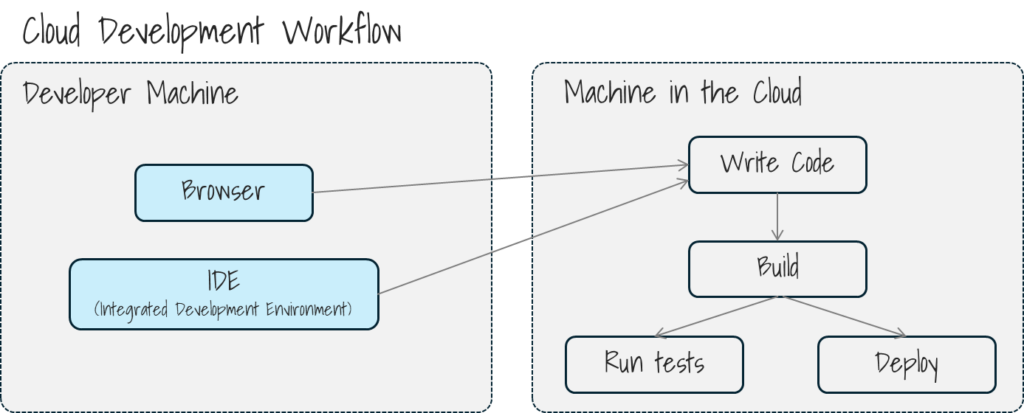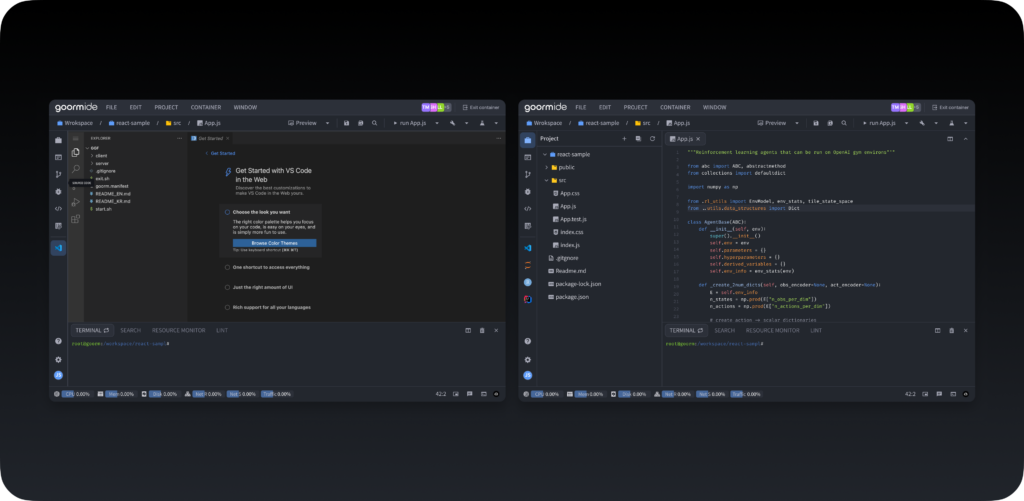Highlighting the fundamental advantages of Cloud Development Environments(CDEs), this article aims to explain how they simplify and enhance the software development process through pre-configured tools, libraries, and dependencies, making them an invaluable asset for developers and platform teams alike.
Imagine a Seamless Development Toolbox
Imagine you have a magic box that travels with you wherever you go. Whenever you are inspired to create something, you simply open the box, and all the pieces you need are instantly available. You can build anything from the Heart of Gold spaceship to Marvin the Paranoid Android without worrying about gathering the necessary parts.

This concept perfectly illustrates Cloud Development Environments (CDEs). Think of it as your ready-to-use Magic Box for software creation. Whenever inspiration strikes, developers can dive straight into building without delay.
The Rise of CDEs
Over the past year, the term ‘CDE’ has become increasingly popular. The buzz began with our own discussions, followed by Kent Beck’s insights on reducing complexity in development environments. Gartner then included CDEs in their 2023 Emerging Technologies Hype Cycle, and prominent voices like the Pragmatic Engineer further spotlighted this concept.

As CDEs become more popular, they spark discussions around their application: When should they be used? What do they replace? How do you evaluate a great solution? How can you effectively integrate them, particularly within platform teams? This article aims to provide clarity on how CDEs can boost the success of platform teams and offer a comprehensive understanding for anyone curious about CDEs.
Understanding CDEs
CDEs are on-demand development environments pre-configured with the necessary tools, libraries, and dependencies for writing, testing, and reviewing code. They shift the influence of platform teams leftward, giving them greater control over development environments.
Components of CDEs
Using goormIDE as an example, let’s break down the components of CDEs, known as workspaces in goormIDE’s case.
- Workspaces: These provide the same capabilities as a Linux machine. Accessible through a browser, desktop editors, or command shell via SSH, workspaces can be used on a PC, laptop, tablet, or phone. They are based on Linux and can be automated with configuration files or workspace images such as Docker.
- Customization: Workspaces come pre-installed with tools like Docker, Nix, Go, Java, Node.js, and more. They can be customized to fit specific needs and globally applied across all developers’ workspaces.
- Ephemeral and Isolated: Most users will use a workspace per task, running multiple workspaces in parallel.
CDEs vs. IDEs
People often mistake CDEs for IDEs or cloud IDEs. An IDE is simply a tool for writing code, whereas a cloud IDE functions as a browser-based code editor. However, CDEs offer much more; they integrate with various IDEs and provide all the essential tools needed for efficient software development.
Addressing Key Issues
CDEs solve many problems that modern engineering organizations face, such as:
- Standardization: They create consistency, reproducibility, and stability in development environments.
- Extensibility: They can be customized to fit your existing platform.
- Security: They help developers make secure decisions by default and protect sensitive assets.
Benefits for Platform Teams
Cloud Development Environments (CDEs) greatly simplify the work of platform teams by tackling challenges in three key areas:
- Extensibility:
- Empowers developers to select their favorite code editors.
- Allows environments to be initiated directly from their current workflow.
- Seamlessly integrates with existing platforms and dynamically adjusts resources as needed.
- Security:
- Maintains uniform security protocols across all environments.
- Centralizes sensitive information to enhance data protection.
- Automatically applies the latest security patches and updates.
- Standardization:
- Removes inconsistencies between different development setups.
- Eases the onboarding process with ready-to-use environments.
- Prevents environment drift and maintains uniformity.
Evaluating CDEs
When evaluating CDEs, consider the following:
- Deployment Model: Decide between self-hosted, self-managed, vendor-hosted, or vendor-managed solutions based on your security needs and resources.
- Developer Experience: Ensure the CDEs support your developers’ favourite editors and integrates well with your platform.

The Future of CDEs
CDEs are continually evolving, incorporating advancements like AI and integrating with virtual desktop infrastructures to enhance productivity and security. They are set to become even more essential in modern software development.
Try Modern CDEs
If these advantages resonate with your team’s objectives, consider exploring CDEs with a free trial. Many solutions, such as goormIDE, provide free trials. Utilize ROI calculators to assess the financial benefits of implementing CDEs and present their value to your leadership team.
Cloud Development Environments offer a comprehensive solution to many challenges faced by modern development teams. By adopting CDEs, you can enhance collaboration, improve security, and streamline your development process, positioning your team for greater success.




